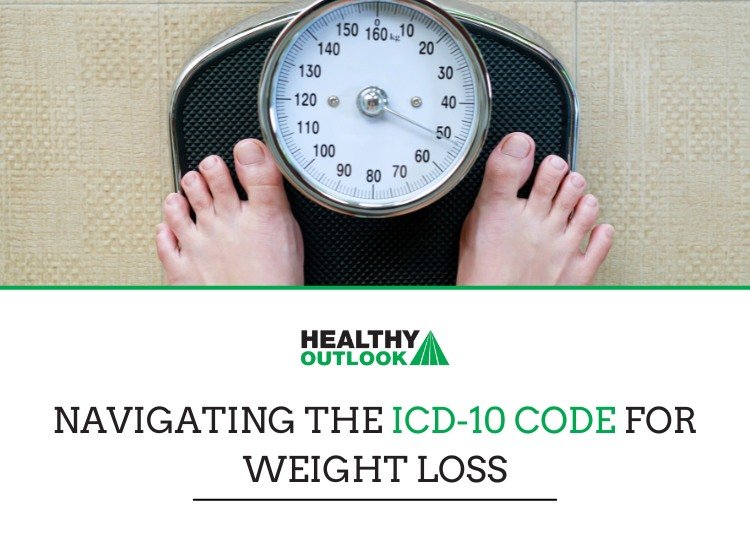Navigating the ICD-10 Code for Weight Loss A Comprehensive Guide
Getting the right medical codes for weight loss is a big deal in healthcare. It helps everyone from doctors to insurance companies understand what's going on with a patient. We're talking about the ICD-10 code for weight loss, which is like a special tag for health conditions. This guide will help you understand how to use these codes correctly, especially R63.4 for abnormal weight loss, and why it matters for patient care and getting paid.
Key Takeaways
The main code for weight loss, R63.4, is for when someone loses weight without trying, and it often points to other health problems.
It's important to know the difference between losing weight on purpose and losing it by accident; this changes how you use the code.
Good notes in a patient's file are super important for using the right icd 10 code for weight loss and making sure insurance claims go through smoothly.
Being very specific with your codes helps avoid problems with insurance and makes sure you get paid correctly.
Using electronic health records (EHR) can make coding easier and more accurate, which is good for everyone involved.
Understanding the Core icd 10 code for weight loss
The Significance of R63.4: Abnormal Weight Loss
The ICD-10 code R63.4 signifies abnormal weight loss, but it's important to understand what that means in a clinical setting. It's not just about someone wanting to lose a few pounds; it's about significant, unintentional weight reduction that could indicate an underlying health issue. This code is used when a patient experiences a notable decrease in body weight that isn't due to planned dieting or exercise. It's a signal to investigate further and determine the root cause of the weight loss.
Distinguishing Unintentional Versus Intentional Weight Loss
It's really important to tell the difference between weight loss that's on purpose and weight loss that isn't. If someone is actively trying to lose weight through diet and exercise, that's intentional. The localized adiposity ICD-10 code wouldn't apply in that case. Unintentional weight loss, on the other hand, is when someone loses weight without trying. This could be a sign of a medical condition, like cancer, depression, or a digestive disorder. Here are some key differences:
Intentional weight loss: Planned, often with diet and exercise.
Unintentional weight loss: Unplanned, potentially indicative of underlying health issues.
Documentation is key: Always note whether the weight loss was intentional or not.
When to Apply the R63.4 Code
So, when do you actually use the R63.4 code? It's not as simple as just seeing a lower number on the scale. Here's a breakdown:
Significant weight loss: Usually defined as 5% or more of body weight over 6-12 months.
Unintentional: The patient isn't actively trying to lose weight.
Further investigation: The weight loss warrants further medical evaluation to determine the cause.
Using the R63.4 code correctly is important for accurate medical billing and for tracking health trends. It helps healthcare providers identify patients who need further evaluation and treatment. It's also important to consider other codes, like those related to icd 10 code for weight gain, to get a full picture of the patient's health.
Related ICD-10 Codes in Weight Management
Obesity and Overweight Classifications (E66 Series)
When dealing with weight management, it's important to understand the E66 series of ICD-10 codes. These codes cover obesity and overweight conditions, which are often the primary reasons patients seek weight loss interventions. Accurate coding here is key for treatment plans and insurance coverage. Here's a quick rundown:
E66.01 – Morbid obesity due to excess calories
E66.09 – Other obesity due to excess calories
E66.3 – Overweight
Using the right code from the E66 series helps paint a clear picture of the patient's condition. This is important not just for medical reasons, but also for administrative tasks like billing and insurance claims.
Dietary Counseling and Surveillance (Z71.3)
ICD-10 code Z71.3 is used for dietary counseling and surveillance. This code is often paired with BMI codes to provide a complete clinical picture. It's particularly useful when the primary focus is on guiding the patient through dietary changes. Think of it as the go-to code when the main intervention is advice and monitoring. Here's why it matters:
It shows that the patient is receiving active guidance on their diet.
It can be used alongside other codes to give a fuller picture of the patient's health.
It's essential for weight loss management programs that emphasize lifestyle changes.
Codes for Abnormal Weight Gain (R63.5)
While we're talking about weight loss, it's worth mentioning the flip side: abnormal weight gain. The ICD-10 code R63.5 covers this. It's important to differentiate between weight loss and weight gain, as they often have different underlying causes and require different approaches. Here's a simple comparison:
| Condition | ICD-10 Code | Description |
|---|---|---|
| Abnormal Weight Loss | R63.4 | Unintentional or significant weight reduction |
| Abnormal Weight Gain | R63.5 | Unintentional or excessive weight increase |
It's important to consider these points:
R63.5 indicates an increase in body mass beyond what's considered normal.
It can be linked to various factors, including lifestyle, medications, or underlying health issues.
Proper documentation is needed to support the use of this code.
Clinical Documentation for Accurate icd 10 code for weight loss
Essential Elements of Patient Records
Good patient records are super important for getting the right ICD-10 codes for weight loss. Accuracy is key. You need to include:
Patient's medical history.
Physical exam findings.
Detailed notes on weight loss progress (or lack thereof).
Any underlying conditions that might be contributing.
Medications and supplements the patient is taking.
Clear and complete documentation helps support the medical necessity of the treatment and ensures appropriate coding.
Linking Symptoms to Definitive Diagnoses
It's not enough to just note the weight loss. You have to connect the dots between the patient's symptoms and a specific diagnosis. For example, if a patient is experiencing unintentional weight loss along with fatigue and loss of appetite, you need to investigate and document potential causes like depression, hyperthyroidism, or even cancer.
Best Practices for Comprehensive Charting
To make sure your charting is up to par, consider these best practices:
Use standardized templates or checklists to ensure all relevant information is captured.
Document all conversations with the patient regarding their weight loss journey, including dietary and exercise advice.
Regularly update the patient's chart with progress notes and any changes in their condition.
Be specific! Avoid vague terms like "weight loss" and instead quantify the amount of weight lost over a specific period.
Include BMI measurements at each visit, when appropriate.
Navigating Insurance Claims and Reimbursement
Avoiding Common Claim Denials
Dealing with insurance companies can be tricky. One of the biggest headaches is getting claims denied. To avoid this, make sure your documentation is super clear. Insurance companies want to see medical necessity for any weight loss treatment. This means showing how the patient's weight is affecting their health. For example, if a patient has high blood pressure or diabetes related to their weight, document that connection clearly. Also, double-check that you're using the most specific ICD-10 code for weight loss possible. Vague codes can lead to denials.
Use specific codes.
Document medical necessity.
Double-check for errors before submitting.
Ensuring Medical Necessity for icd 10 code for weight loss
Medical necessity is the cornerstone of getting weight loss treatments covered by insurance. It's not enough to just say a patient wants to lose weight. You need to show that their weight is causing or worsening a health problem. This could include things like heart disease, sleep apnea, or osteoarthritis. The more detailed you are in your documentation, the better. Include specific measurements like BMI, waist circumference, and blood pressure readings. Also, note any lifestyle changes the patient has tried and how they've impacted their health.
Clear documentation of medical necessity is important. It helps justify the treatment plan and shows the insurance company why it's needed.
Impact of Accurate Coding on Financial Outcomes
Accurate coding directly affects your financial bottom line. When you use the right codes, you're more likely to get reimbursed fully and on time. This means more money for your practice and fewer headaches dealing with appeals. On the flip side, inaccurate coding can lead to claim denials, delays in payment, and even audits. Here's a quick look at how coding accuracy impacts finances:
| Coding Accuracy | Financial Outcome |
|---|---|
| Accurate | Full and timely reimbursement |
| Inaccurate | Denials, delays, potential audits |
To improve coding accuracy, consider these steps:
Provide regular training for your coding staff.
Use coding software to help identify errors.
Conduct internal audits to catch mistakes early.
The Role of Specificity in icd 10 code for weight loss
Why Detailed Documentation Matters
When it comes to ICD-10 coding for weight loss, the level of detail in your documentation can significantly impact accuracy and reimbursement. Vague or incomplete records can lead to claim denials and a misrepresentation of the patient's condition. Detailed documentation ensures that the correct code is assigned, reflecting the true nature of the patient's weight loss journey. Think of it like this: the more specific you are, the clearer the picture you paint for insurance companies and other healthcare providers.
Impact of Unspecified Codes
Using unspecified codes, like a generic "Obesity, unspecified" (E66.9), might seem easier in the short term, but it can cause problems down the road. These codes don't provide enough information about the patient's specific condition, potentially leading to lower reimbursement rates or even claim rejections. Plus, unspecified codes don't contribute to a clear understanding of the patient's health status, which can affect treatment plans and future care. It's always better to aim for the most specific code possible to avoid these issues. For example, instead of E66.9, try to determine if it's drug-induced obesity (E66.1) or morbid obesity (E66.01).
Achieving Optimal Coding Precision
To achieve the best coding precision, consider these steps:
Thoroughly review patient records.
Link symptoms to definitive diagnoses.
Use available clinical decision support tools.
Accurate coding not only helps with reimbursement but also contributes to better patient care. When you use specific codes, you're providing a more complete picture of the patient's condition, which can inform treatment decisions and improve outcomes. It's about more than just getting paid; it's about providing the best possible care.
Here's a simple table to illustrate the impact of coding precision:
| Code Specificity | Impact on Reimbursement | Impact on Data Analysis | Impact on Patient Care |
|---|---|---|---|
| High | Higher | More Accurate | Improved |
| Low | Lower | Less Accurate | Potentially Compromised |
Common Pitfalls in Weight Loss Coding
Misinterpreting Unintentional Weight Loss
One common mistake is not digging deep enough to find the root cause of unintentional weight loss. It's easy to just code R63.4 (Abnormal weight loss) and move on, but that might not tell the whole story. For example, weight loss could be a symptom of something more serious, like cancer or depression. Always check the patient's history and other symptoms to see if there's a more specific diagnosis that should be coded instead. This ensures a more accurate representation of the patient's health status.
Overlooking Co-morbid Conditions
Weight loss rarely happens in isolation. Patients often have other health issues that contribute to or result from their weight changes. Failing to code these co-morbid conditions can lead to incomplete and inaccurate medical records. For instance, a patient with obesity (E66.9) might also have diabetes (E11.9) or hypertension (I10). Make sure to document all relevant conditions to paint a complete picture of the patient's health. Remember, accurate coding impacts financial outcomes and treatment planning.
Inadequate Documentation Support
Coding is only as good as the documentation it's based on. If the patient's chart lacks sufficient detail, it becomes difficult to assign the correct codes. This is especially true for weight loss, where factors like diet, exercise, and psychological state play a big role.
Here are some areas where documentation often falls short:
Specific dietary plans are not noted.
Exercise routines are vaguely described.
Psychological factors influencing weight are ignored.
Clear and comprehensive documentation is the backbone of accurate coding. Without it, even the most skilled coder will struggle to assign the right codes. This can lead to claim denials, audit risks, and ultimately, compromised patient care.
To improve documentation, consider using templates and checklists to ensure all relevant information is captured. This will not only make coding easier but also improve the quality of care.
Expert Insights on icd 10 code for weight loss
Perspectives from Medical Coders
Medical coders bring a practical viewpoint to the application of icd 10 code for weight loss. They emphasize the importance of clear and consistent documentation from physicians to ensure accurate code assignment. Coders often face challenges when documentation lacks specificity, leading to potential claim denials. They suggest regular training sessions for clinical staff to improve documentation practices and reduce coding errors.
Understanding payer-specific guidelines is key.
Staying updated with coding changes is a must.
Collaboration with physicians is essential for clarification.
Physician Best Practices for Documentation
For physicians, detailed and precise documentation is the cornerstone of effective coding. It's not enough to simply note "weight loss"; the underlying cause, severity, and any associated conditions must be clearly stated. This ensures that the most appropriate icd 10 code for obesity is selected, reflecting the patient's condition accurately. Physicians should also be aware of the common pitfalls in weight loss coding, such as misinterpreting unintentional weight loss or overlooking co-morbid conditions.
Document the percentage of weight loss over a specific time period.
Include any relevant lab results or diagnostic findings.
Specify whether the weight loss is intentional or unintentional.
Clear documentation is not just about coding; it's about providing the best possible care for the patient. When physicians take the time to document thoroughly, it benefits everyone involved in the healthcare process.
Healthcare Administrator Strategies for Compliance
Healthcare administrators play a vital role in ensuring compliance and optimizing financial outcomes related to weight management coding. This involves implementing robust auditing processes, providing ongoing training for coding and clinical staff, and integrating coding guidelines into EHR systems. By proactively addressing potential coding errors and promoting best practices, administrators can minimize claim denials and maximize reimbursement rates. They should also stay informed about changes to icd 10 code for morbid obesity and other relevant coding guidelines.
Establish regular internal audits of coding practices.
Provide access to coding resources and support for staff.
Monitor key performance indicators related to coding accuracy and efficiency.
Integrating icd 10 code for weight loss with EHR Systems
Streamlining Workflow with Electronic Health Records
Electronic Health Records (EHRs) are really helpful for managing weight loss. They make it easier to keep track of patient info and use the right ICD-10 codes. Using an EHR can make your workflow smoother and more efficient.
Centralized patient data storage.
Improved communication between healthcare providers.
Reduced paperwork and administrative burden.
Automated Coding Assistance
EHR systems often come with built-in tools that can help with coding. These tools can suggest the correct codes based on the information you enter, which can reduce errors and save time. Automated coding assistance can be a real game-changer.
EHRs can provide prompts and reminders to ensure all necessary documentation is completed, which supports accurate coding.
Enhancing Data Accuracy and Efficiency
Using an EHR can improve the accuracy of your data and make your practice more efficient. When you have all the information in one place, it's easier to track patient progress and make informed decisions. Plus, it helps with billing and reimbursement.
Here's a quick look at the benefits:
Better data quality.
Faster access to patient information.
Improved billing accuracy.
Reduced risk of errors.
Auditing and Compliance for Weight Loss Coding
Internal Audit Processes
Internal audits are a key part of making sure your weight loss coding is accurate and compliant. It's not just about avoiding penalties; it's about ensuring you're getting fairly paid for the services you provide. Here's what an internal audit might look like:
Regular chart reviews: Pick a sample of patient charts each month and check them against coding guidelines.
Coding accuracy assessments: Have a certified coder review the work of other coders to identify errors.
Documentation audits: Make sure that all the necessary documentation is present and supports the codes being used.
Audits should be seen as a way to improve, not to punish. The goal is to find areas where your team can do better and provide the training and resources they need.
Mitigating Regulatory Risks
Staying on top of regulatory changes is a constant job. Here's how to reduce the risk of running into trouble:
Stay updated: Subscribe to newsletters from coding organizations and regulatory agencies.
Training: Make sure your coding staff gets regular training on new guidelines and regulations.
Compliance program: Develop a written compliance program that outlines your policies and procedures for coding and billing.
Continuous Improvement in Coding Practices
Coding isn't static; it's always changing. To keep your coding practices sharp, consider these steps:
Feedback loops: Get feedback from payers on claim denials and use that information to improve your coding.
Data analysis: Look at your coding data to identify trends and areas where errors are common.
Technology: Use coding software and tools to automate some of the coding process and reduce errors. For example, you can use secondary diagnoses to improve coding accuracy.
Continuous improvement is the name of the game. By regularly reviewing and updating your coding practices, you can make sure you're always providing the best possible care and getting paid fairly for it.
Future Trends in Weight Management Coding
Anticipated Updates to ICD-10
ICD-10 isn't static; it evolves. We can expect future updates to better reflect the nuances of weight management. These revisions might include more specific codes for different types of obesity or weight loss etiologies. Keep an eye on official announcements from organizations like the CDC and WHO. Staying informed about these changes is key to accurate coding.
Emerging Technologies in Coding
Technology is changing how we code. AI-powered coding tools are becoming more common, promising to automate some processes and reduce errors. These tools can analyze patient records and suggest appropriate codes, but human oversight remains essential. The integration of these technologies could significantly streamline the coding workflow.
Here's a quick look at potential tech impacts:
Natural Language Processing (NLP) for automated chart review.
Machine learning algorithms to predict coding errors.
Blockchain for secure and transparent data sharing.
Adapting to Evolving Healthcare Standards
Healthcare is always changing, and coding must keep up. As new treatments and approaches to weight management emerge, the coding system needs to adapt. This includes addressing the coding implications of telehealth, personalized medicine, and integrated care models. For example, the introduction of new obesity classifications based on BMI requires coders to update their knowledge and skills.
The future of weight management coding will require a blend of technical expertise and clinical understanding. Coders will need to be proficient in using new technologies while maintaining a strong grasp of medical concepts. Continuous learning and adaptation will be crucial for success.
Wrapping Things Up
So, there you have it. Getting the ICD-10 codes right for weight loss isn't just about paperwork; it really helps make sure people get the right care and that everything runs smoothly with billing. Knowing when to use codes like R63.4 for unexpected weight loss versus something like E66 for obesity is a big deal. It helps doctors and clinics keep good records and avoid problems with insurance. It might seem like a lot of details, but paying attention to these codes means better care for patients and fewer headaches for everyone else involved.
Frequently Asked Questions
What is the main ICD-10 code for weight loss?
The main ICD-10 code for unexpected weight loss is R63.4. It's used when someone loses weight without trying, and doctors need to figure out why. This code helps track and understand possible health problems causing the weight loss.
How do you tell the difference between accidental and on-purpose weight loss in coding?
It's super important to tell the difference! R63.4 is for weight loss that happens by itself, like when someone is sick. If someone is losing weight on purpose, like through diet and exercise, you'd use different codes related to obesity or health counseling (like codes from the E66 series or Z71.3). This helps doctors and insurance companies know the full story.
When is it okay to use the R63.4 code?
You should use R63.4 when a patient has lost weight without trying, and there's no clear reason for it yet. It's often a first step to show that more medical checks are needed to find the cause. You wouldn't use it if the weight loss is expected, like after surgery or a new diet plan.
What kind of notes do doctors need to write for weight loss coding?
For weight loss, doctors need to write down everything clearly. This includes how much weight was lost, over what time, and any other symptoms the patient has. They also need to list any tests done and what they think might be causing the weight loss. Good notes help make sure the right code is used.
Does using the right code really matter for insurance?
Yes, it really does! If the code isn't right, or the notes aren't clear, insurance companies might not pay for the patient's care. This can cause problems for both the patient and the doctor's office. Accurate coding means less hassle and better care.
What does 'being specific' mean in medical coding?
Being very specific means giving as much detail as possible. Instead of just saying 'weight loss,' a doctor might write 'unexplained weight loss of 15 pounds in 2 months with fatigue.' This helps other doctors and coders understand the situation better and pick the most accurate code.
What are some common mistakes when coding for weight loss?
A common mistake is using R63.4 when the weight loss is actually on purpose, or not adding other codes when there are other health issues. Another big mistake is not writing enough details in the patient's chart to support the code used. This can lead to problems with insurance.
How do computer systems help with weight loss coding?
Electronic Health Records (EHR) systems can make coding much easier. They can suggest codes based on the doctor's notes, and they help keep all the patient's information in one place. This makes the whole process faster and more accurate, reducing errors and saving time.





